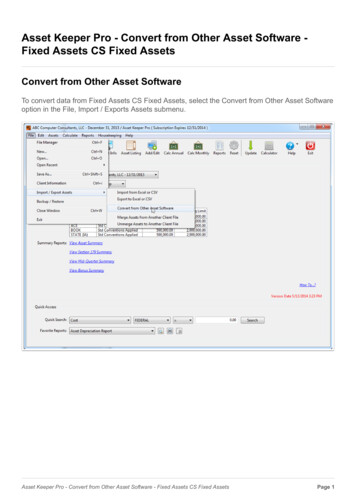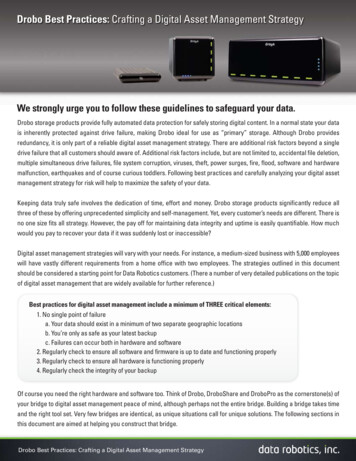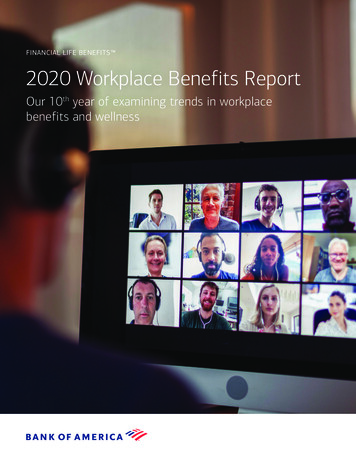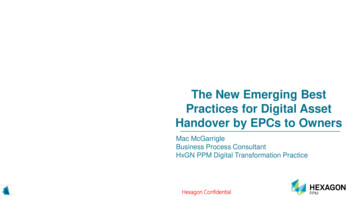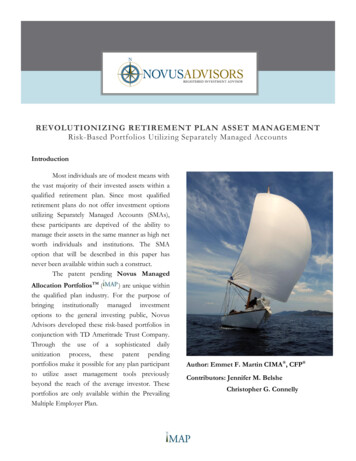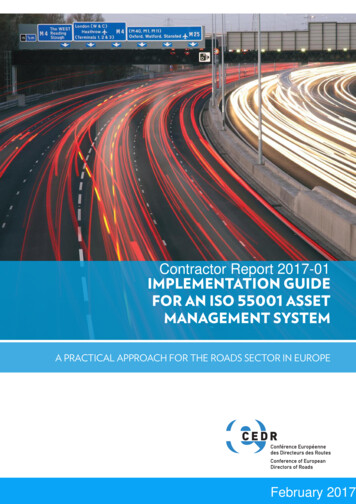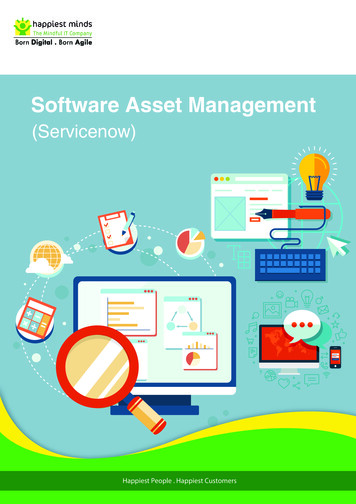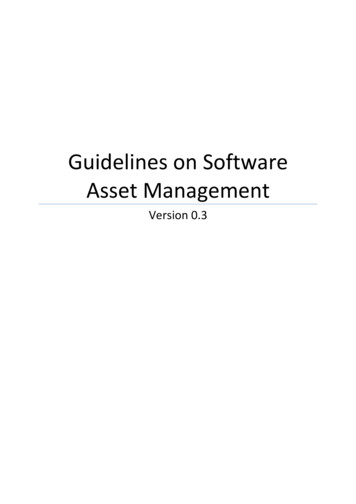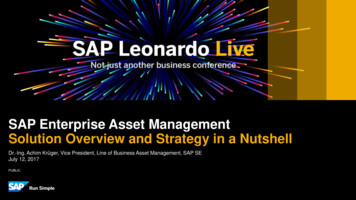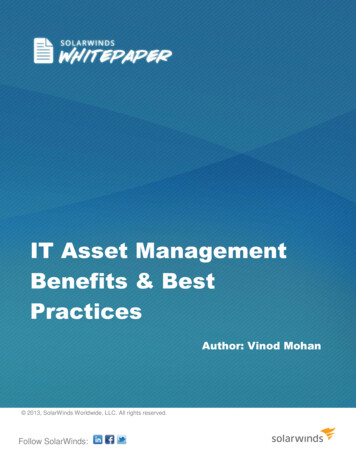
Transcription
IT Asset ManagementBenefits & BestPracticesAuthor: Vinod Mohan 2013, SolarWinds Worldwide, LLC. All rights reserved.Follow SolarWinds:
IntroductionThe fact that your IT infrastructure is growing is undisputed; and you know it! Each day new users are being addedand so are IT assets – hardware and software. It’s the responsibility of system admins to track and manage theseassets. Potential IT issues could be resolved quickly, efficiently, and with better IT administration support, if you havethe visibility into all the IT assets that exist in the organizational IT landscape – network, data center, remote sites, userworkstations, etc.What is IT Asset Management?IT asset management (ITAM) is a set of business practices that join financial, contractual, and inventory functions tosupport life cycle management and strategic decision making for the IT environment [1]. Managing IT assets allows youto get maximum value from the use of the assets, right-size IT inventory, and optimize inventory purchase decisionsand strategies.IT asset management provides you the means to achieve complete visibility into your IT infrastructure inventory,helping you gain an in-depth understanding of: What systems and equipment exist Where components reside How they are used What they cost When were they added to the inventory Whether they have an expiry date How they impact IT and business servicesThis level of visibility into asset details will help organizations improve infrastructure efficiency and performance, andminimize related overhead expenses. All organizations, in one way or the other, perform ITAM. It’s important toimplement ITAM practices intelligently, in order to achieve IT operational efficiency, financial accountability of assetpurchase, simpler auditing and compliance, and long-term asset manageability and maintenance.In this white paper, we’ll focus on the benefits of proper IT asset management, best practices, and how to implementit, so it benefits your IT teams, business, end-users and employees.IT Asset Management MethodologyThe major goal of ITAM is to establish a centralized asset repository that accounts for the presence and purchase ofall your hardware and software inventory. To achieve this, ITAM methodology comprises the following steps:Follow SolarWinds:2
Asset discovery, data capture and storage – Discovering all hardware and software components of ITinventory on the IT infrastructure and capturing their details, such as the type of asset, make, specification,etc., and storing it in an asset repository Asset tracking – Being able to identify and track change in the location of assets, increase or decrease thenumber of assets, track assignment status and user information Asset lifecycle management – Being able to capture the asset lifecycle data right from requisitioning,purchase and assignment, to expiry and decommissioning Asset reporting and alerting – Being able to generate asset inventory reporting, and receive alerts on assetwarranty and lease expirationCentralized organization-wide ITAM process and asset repository will also help you support various ITIL functions,such as configuration management, incident management, problem management, and service level management.While we are looking to build a centralized asset repository, it’s important to understand the difference between assetrepository and configuration management database (CMDB). The CMDB is an evolution of the asset repository whichis part of the ITIL framework. Beyond the scope of asset discovery and tracking, the CMDB is integrated with servicedesk functions and is part of IT service management and change management.Hardware Asset ManagementHardware asset management is the process of tracking and managing the physical components of computers andcomputer networks, from acquisition through disposal. The goals of hardware asset management are to account for allhardware assets on the IT infrastructure to provide comprehensive inventory visibility. Further, to help with vendorcontract and lease management, and to assist in making budgetary forecasts based on the stock of assets andbusiness requirement.Software Asset ManagementSoftware asset management is similar to hardware asset management, but focuses on software assets, includinglicenses, versions, and installed endpoints. ITIL states that the goals of software asset management are to reduce ITcosts and limit business, legal and security risks related to the ownership and use of computer software, whilemaximizing IT responsiveness and end-user productivityLet’s dive a little deeper and understand the various benefits of IT asset management and some best practices toimplement it in your IT framework.Follow SolarWinds:3
Benefits of IT Asset ManagementGain Control Over IT InventoryIf you are carrying out an effective asset management practice for your organization, you’d benefit from deeper visibilityinto your hardware and software assets. Therefore, IT Admins and support personnel should look further into viewingand managing asset details of the end-user system. Asset management gives you the ability to easily view thehardware and software components of a computer, server, or any other network infrastructure. Traceability of assetsacross your IT landscape gives you better IT administration control and accountability. Using an automated assetdiscovery and management functionality, along with your server and application monitoring tool will allow you to seethe computer inventory details, all while you are actually troubleshooting a server crash or application performanceissue. You can also find out if an employee has any unauthorized and non-compliant hardware or software on theirenterprise workstation.A server or a workstation will benefit from asset management data covering the following: Drivers Out of Band Management Firmware Peripherals Graphics and Audio Ports and USB Controllers Hard Drives Processors Hosted Virtual Machines Removable Media Logical Volumes Software Inventory Memory Storage Controllers Network Interfaces System Information Operating System Updates Applied OS Update InformationAsset Lifecycle ManagementHardware or software, there’s bound to be a disposal or replacement date. Asset management allows you to keeptrack of when a hardware is purchased, how long has it been used, whether there’s a lease expiring on the component,etc. For system administrators, it’s important to know what version of software and how long your end-users have beenrunning this software on their system, and whether their OS is current.This is actionable data IT teams utilize to decide if they should replace an old or faulty hardware, uninstall or patch avulnerable application, or update the firmware on the system. Vendor contract management should familiarizethemselves with Asset information. In turn, they will know when to extend or renew a contract with your vendor orFollow SolarWinds:4
hardware/software provider based on contract, purchase order, and expiry information fed into the asset managementsystem.Strategic Inventory Planning & Procurement ForecastWhen you keep track of what inventory you have in your IT infrastructure, it becomes easier to plan for future spendingon assets. Without knowing what currently exists in your end-user systems – both hardware and software – it is verydifficult to plan on procurement budget. You may actually end up procuring more assets, and those of which that arenot required. Centralized and streamlined asset management lets you scan your entire network and list which hardwareand software your system is using. Being able to collectively view inventory data with storage capacity of end-usersystems is useful for storage utilization analysis and budget planning. This information becomes critical as you startcharting out your financial planning, allowing you to plan well in advance for future asset needs, and maximizing existingasset utilization and eliminate unnecessary expenditure.Increased Accountability to Ensure ComplianceKeeping track of your IT inventory and automatically updating it using asset management systems will help you monitorhardware and software components of your network computers, and identify whether unapproved or harmful softwareor hardware is installed. Ensuring compliance with corporate security policies and desktop standards is a must fororganizations, and efficient asset management of IT inventory will help you accomplish that.By allowing system administrators to quickly isolate vulnerabilities, such as illegal/unauthorized software, outdatedsoftware, games and unauthorized/malicious downloads, ITAM system makes it easier to see where potential risksmay exist, so they can be prevented before major problems arise.Not just helping you to keep systems and assets compliant, but a good ITAM solution will also provide IT inventoryreports for compliance auditing.Automated Asset Discovery & TrackingMany companies manage their IT asset inventory using manual, paper-intensive processes, which drain resources andare highly prone to inaccuracies and inconsistencies. Spreadsheets are used by many IT teams to manually enterdetails of the assets and then they constantly have to modify assets as they update. With the introduction of IT assetmanagement solutions and asset management integrations with systems and network monitoring tools, this processhas been made amazingly simpler and quicker.Follow SolarWinds:5
ITAM systems perform automated device discovery on your enterprise LAN. For example, if there are Windows servers and operating systems on your network, then using WMI, the ITAM tool can discover the Windows nodes andfetch all hardware and software asset information from them.With the pace that enterprise networks are growing and IT systems are getting updated, an automated assetmanagement method is a must to constantly keep abreast of asset updates and changes. Automated ITAMconsiderably saves manual effort and time, and results in lesser errors and personnel overheads.Best Practices for Implementing IT Asset ManagementAsset Management with Server & Application Management SystemFor IT admins, application performance management (APM) is key to ensuring undisrupted business service throughhigh availability and performance of applications and server infrastructure. Incorporating asset management as part ofyour APM solution will help you identify the right server assets, what’s installed in the server, whether the server hasan expiring lease and warranty, or has enough storage capacity, etc. while you actually troubleshoot and remediateapplication or server hardware health issues. View how this will look Follow SolarWinds:6
Asset Management with IT Help DeskIt makes a lot of sense to incorporate asset management into your IT help desk. IT is ultimately the hardware andsoftware assets that your users are creating trouble tickets and service requests for. Being able to capture the entireasset data of your IT inventory including purchase order, parts and billing information will be really useful as you providehelp desk support. It’ll be even more beneficial if your help desk is able to associate and tag trouble tickets with specificassets so you can track the history of service requests.Integrating asset management with help desk results and a more efficient ITIL support, change management andoverall service request fulfillment. View how this will look Follow SolarWinds:7
Asset Management with Patch Management & Software DistributionA patch management solution scans your system for critical and vulnerable software and third-party applications thatneed to be updated to mitigate security risks. Once the systems with vulnerable apps, and the apps themselves areidentified, then the system admin will patch them with the latest version of the software or operating system. Assetmanagement plays a crucial role here as all the servers, workstations and notebook assets on the IT environment haveto be discovered first and then their software inventoried.Follow SolarWinds:8
Asset Management with Network Configuration & Change Management (NCCM)The application of asset management is a little different with NCCM as it applies more to network devices, such asrouters, switches and firewalls. As network administrators use network configuration & change management tools tomanage device configurations, it’s also important to the management of network device inventory. NCCM solutionsoffer a device end-of-life (EOL) management feature that helps you manage the lifecycle of your network assets, whothe manufacturer is, and when the product will be EOL’d. This will help in preparing budget forecasts for productmaintenance renewal and device replacement planning. View how this will look ConclusionAs we saw in this paper, asset management is not an option for IT teams. ITAM spans across by simplifying IToperations, improving resource productivity, supporting compliance, and asset procurement planning. Whether you area small, mid-size, or large enterprise, IT asset management is something you should definitely implement. Simplified,centralized and automated asset management is key to improving your overall IT administration’s operationalefficiency. Take control of your IT asset inventory, ensure you stay updated of asset changes in your IT environment!About SolarWindsSolarWinds (NYSE: SWI) provides powerful and affordable IT management software to customers worldwide. Focusedexclusively on IT Pros, we strive to eliminate the complexity in IT management software that many have been forced toaccept from traditional enterprise software vendors. SolarWinds delivers on this commitment with unexpected simplicitythrough products that are easy to find, buy, use, and maintain, while providing the power to address any IT managementproblem on any scale. Our solutions are rooted in our deep connection to our user base, which interacts in our onlinecommunity, thwack, to solve problems, share technology and best practices, and directly participate in our productdevelopment process. Learn more at http://www.solarwinds.com.Follow SolarWinds:9
computer networks, from acquisition through disposal. The goals of hardware asset management are to account for all hardware assets on the IT infrastructure to provide comprehensive inventory visibility. Further, to help with vendor contract and lease management, and to assist in ma

